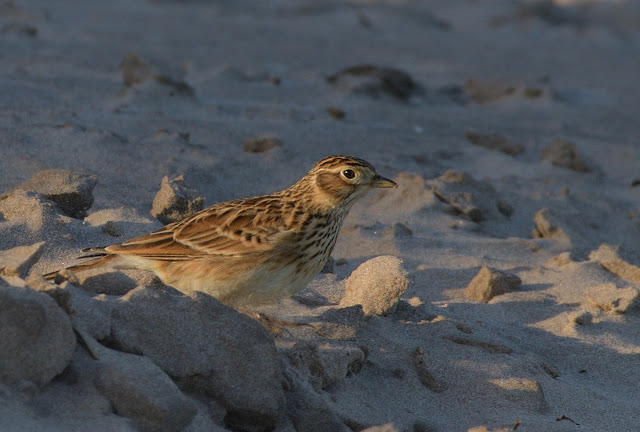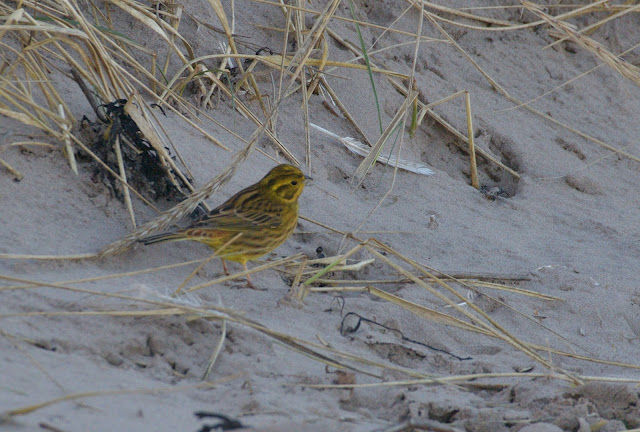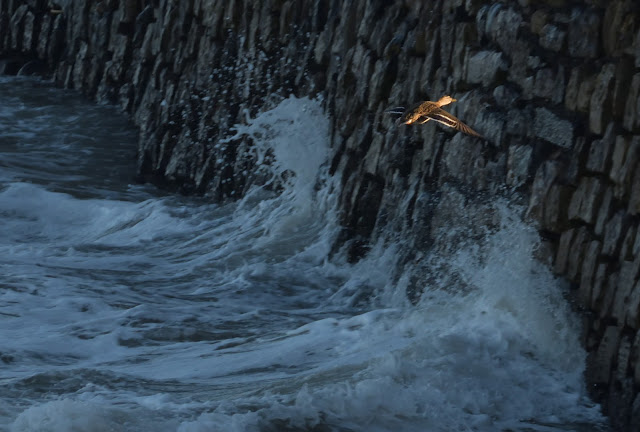Having failed to make it to Fife on Monday with Ian, due to the weather, Ian suggested that it might be possible to 'do' Fife on Tuesday, as it too was a public holiday. Needless to say, I was up for that. Ian messaged me in the evening to say that we were good to go on Tuesday morning with a similar 0800 pick-up time to Monday's Angus coast trip. Our main target species were likely to be the Smew and Black Necked Grebe at Cameron Reservoir, as well as Pintail and Brent Geese in Balgove Bay. There were also plenty of other potential year-ticks that we might run into. With my year-list sitting on 87 species I would need to add 13 to reach the 100 species before I returned to work target figure that I set in years when I can get out of Dundee (otherwise the total is 75 species for Dundee - which is actually slightly more difficult to achieve).
 |
| Skylark |
Herring Gull was noted as I wandered round to meet Ian, and a skein of Pink Footed Geese overflew the car as we were about to set off. Although the light was better than the day before it still took around 20 minutes to add anything else with a Magpie in Guardbridge and Woodpigeon as we arrived in St Andrews. Rather than head straight for Cameron Reservoir we decided to check St Andrews Bay for Scoters, Scaup and Grebes/Divers first. As we were ahead of most of the walkers there were still a number of birds present on the beach. Common, Black Headed, Herring and Great Black Backed Gulls were noted (including a yellow ringed GBBG just a bit too far away to read off). Starling, Jackdaw, Rook and Pied Wagtail were round about in the Bruce Embankment car park and down on the rocks.
Out in the bay were a number of Common Scoters and a flock of Scaup. A Curlew flew past. I checked the cliffs for the roosting Peregrine but couldn't see it. There was also a surprising lack of Fulmars on the cliffs. A Cormorant was seen on the water before we headed up to the area next to the Castle to scan out over the outer parts of the bay. This proved to be quite productive with Velvet Scoter, Great Crested Grebe, Red Throated Diver and a distant flock of Fulmar on the water all seen. Eider and Wigeon were also seen a bit closer in to the rocks. Scanning among the rocks added Turnstone, Grey Heron, Carrion Crow, Redshank and Oystercatcher. A Kestrel flew in and landed on the castle and ignored me as I took some closer photos over the wall. A Wren called from nearby.
We eventually added Long Tailed Duck to the list as well as Feral Pigeon and Rock Pipit. Having spent around 80 minutes scanning out over the bay we decided it was time to head for Cameron Reservoir. There was a small flock of Whooper Swans in the field by the potholed access road. Chaffinch and Reed Bunting were in bushes at the car park. On the water close by were Mallard, Tufted Duck and Goldeneye. A birder who was just leaving confirmed that both the Smew and the Grebe were around and handily let us know where he'd seen them. We set off along the northern side of the reservoir, stopping to scan at any opportunity which allowed us to see the water from the path. This added Goosander relatively quickly.
Smaller birds were rather elusive though both Blue Tit and Siskin were found. About 2/3 of the way along the track we found a partially open area and Ian managed to find the Black Necked Grebe close in to the bank, from there. There was a bird perched in a conifer that I had made a mental note to check after looking at the Grebe. Ian checked it before I did. It turned out to be a rather nice bonus Brambling. We continued round to the rather exposed end of the reservoir and scanned from there for the Smew. A flock of Lapwing wheeled up from distant fields. A photographer who had been sat at the far end wandered along to let us know the Smew had just flown to the car park end. Checking Flickr later I realised the photographer was Keith Simpson who I hadn't met previously. I asked via his Smew photos if it was him, and he confirmed that it had indeed been him.
We scanned and scanned to very little avail before we were joined by another birder. As Ian was between me and them I didn't realise that it was Susan until she spotted me. As Ian hunted for the Smew, I attempted to refind the Black Necked Grebe in my scope to let Susan see it (she'd left her scope in the car). Ian refound the Smew, much closer than the far end, and we all managed to get views of it, though it wasn't staying on the surface long. Mission accomplished though. Coot and Cormorant were also seen. We headed off, Susan going north, Ian and I going south, with another 2 birders who I'd also let see the Grebe through my scope not far behind us. We added Song Thrush, Robin, Stock Dove, Coal Tit, a heard only Great Spotted Woodpecker and a couple of Buzzards on the walk back, but it was rather quiet overall.
We weighed up our options for the afternoon before settling on Out Head and Balgove Bay. Snow Bunting had been seen earlier that morning near Out Head so we parked the car and wandered out along the top end of the beach. A Stonechat flitted ahead of us and a Sanderling was chased by an off the lead dog. A Pied Wagtail and a very showy Skylark were also feeding along the strandline but the only buntings we found were a small group of Yellowhammers. Rounding the tip of the dunes we found the strong winds coming right down the Eden to be a bit annoying for keeping our scopes steady. A couple of distant Little Egrets roosting and a few Ringed Plover on the beach proved to be the best we could muster with the tide already much further in than expected.
We wandered back through the dunes, discovering a larger flock of Yellowhammers which also contained the Skylark, a House Sparrow and a coupld of Reed Buntings. Further on, Goldfinch was also added. With the tide quite high we chose to head for the Castle area again to see if the Purple Sandpipers were roosting where I've found them before at high tide. They were, along with Turnstones and Redshanks. Another year-tick in the bag, and slowly edging towards the amount required to get me to 100 species. A pair of Greenfinches skulking among the roses nearby were a bit of a surprise. Balgove Bay was our next and likely final stop for the day. We hoped that Pintail and Brent Geese should be easy enough to see if we walked out across the golf course.
A Blackbird flew across in front of the car as we pulled into the car park at the golf course. When we reached the part of the course where it is possible to cut across to look into the bay, between holes, we were fortunate that it wasn't busy. We had to be careful not to spook the birds in the bay, so we stayed back far enough that we could see the birds but most of our outline were shielded by the lay of the land. We could see that there were a number of Pintail and Wigeon close in to shore but there were no Brent Geese to be seen. Further out in the bay were Shelduck and a flock of Dunlin flew around a bit before settling. We skirted past the birds but could still not see any Brents. I realised that there was a possibility that the birds might be in one of the nearby fields. I suggested we check from the end of the golf course, so we continued on past the hide. A Kestrel was seen perched on a small post near the end of the greenkeeper's storage area.
From the fenceline at the end of the golf course we found the field to be full of Curlews but there were no Brents. We wandered up to the top of the banking and I realised that there were birds in the next field, half-hidden by a hedge. I took a photo and sure enough, they were Brent Geese. My 100th species of 2022 and only 4 days in. A Skylark flew past and as Ian checked the pond for Moorhen, a few Curlew and Redshanks flew over. A pair of Mute Swans also flew past. I found a Moorhen skulking below the trees by the small channel running along the fenceline. As we walked back to the car we found a small flock of Skylarks feeding close to the path on the short cropped grass.
As we drove back towards Guardbridge I managed to grab a few photos, despite the hedges, of the Brent Geese. A count from the photos later showed that there were at least 45 of them in the field. There were a few species we hadn't managed to see, one of which was Pheasant. As we passed the site of the old Pickletillum Inn I spotted one just at the edge of the field, giving me species number 101 for the year. I ended the day with 69 species (Ian also had a Snipe at Cameron Reservoir that I missed) of which 14 were new for the year (in bold). Once again, a very successful day's birding with Ian.
 |
| Kestrel |
 |
| Kestrel |
 |
| Scaup |
 |
Whooper Swan
|
 |
Whooper Swan
|
 |
Black Necked Grebe
|
 |
| Brambling |
 |
| Smew |
 |
| Stonechat |
 |
| Skylark |
 |
| Skylark |
 |
| Skylark |
 |
| Yellowhammer |
 |
House Sparrow
|
 |
| Skylark |
 |
| Skylark |
 |
Purple Sandpiper, Turnstone & Redshank
|
 |
| Mallard |
 |
Pintail & Wigeon
|
 |
| Pintail |
 |
| Pintail |
 |
Mute Swan
|
 |
| Skylark |
 |
| Skylark |
 |
| Skylark |
 |
Brent Goose
|
Birds - Blackbird, Black Heaed Gull,
Black Necked Grebe, Blue Tit,
Brambling, Brent Goose, Buzzard, Carrion Crow, Chaffinch, Coal Tit, Common Gull, Common Scoter, Coot, Cormorant, Curlew, Dunlin, Eider,
Fulmar, Goldeneye, Goldfinch, Goosander, Great Black Backed Gull,
Great Crested Grebe, Great Spotted Woodpecker, Greenfinch, Grey Heron, Herring Gull, House Sparrow, Jackdaw, Kestrel, Lapwing, Little Egret, Long Tailed Duck, Magpie, Mallard, Moorhen, Mute Swan, Oystercatcher,
Pheasant, Pied Wagtail, Pink Footed Goose,
Pintail,
Purple Sandpiper, Redshank, Red Throated Diver, Reed Bunting, Ringed Plover, Robin, Feral Pigeon, Rock Pipit, Rook,
Sanderling, Scaup, Shelduck, Siskin, Skylark,
Smew, Song Thrush, Starling, Stock Dove,
Stonechat, Tufted Duck, Turnstone,
Velvet Scoter, Whooper Swan, Wigeon, Woodpigeon, Wren, Yellowhammer.


























